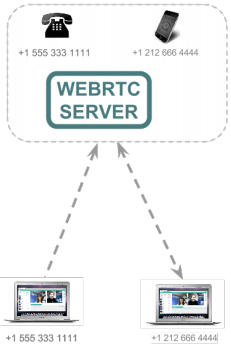Ten use cases for WebRTC in telcos (1/2)
Tier-1 and Tier-2 telcos have been involved in rollouts of IMS, VoLTE, NGN, RCS and Joyn services during the last few years. These telcos have detected some market opportunities for WebRTC services with real business models, which may be summarized as follows.
Residential Web clients

Allow end users to adopt a light WebRTC client to make possible to make voice calls using any device to extend services now limited to the home telephone. Fixed-line customers can make calls from any device and any place, with rates defined for their home services. Depending on the core network strategy, WebRTC licenses will need to be added to existing elements or to a new ad-hoc gateway for this purpose. Integration with advance services like video conferencing, web chats, multi conferencing, desktop sharing or file transfer could be added for browser-to-browser communication or browser-to-IMS connected devices, but it makes more sense for corporate users.
Here is critical for the telco to use the same number for signaling these web calls. This way, when someone is calling to your phone number you should be able to answer the call from your web client. Similarly, when you are using the web client to make a call to the PSTN, your phone number should be use as A-number.For mobile users, WebRTC simplifies the adoption of RCS features on the customer side and seems that it is going to play an important role in Mozilla OS strategy.
Corporate Web client for IMS or NGN
We mentioned before the possibility of using a WebRTC endpoint for residential customers. Corporate users will need some additional features that should be implemented in their WebRTC endpoint. IP centrex solutions implement functionalities like voicemail, call forwarding, etc. that can be provided by the core of the solution, so the WebRTC endpoint should have some implemented methods to access to these features. In addition, WebRTC defines functionalities like desktop sharing, files transfer, etc. that should interwork with the IMS services. Finally, WebRTC can implement a contact list and presence detection, which is one of the most demanded features for professional users and must work with NGN and IMS elements.
The 3GPP standardization body is defining some mechanisms to make possible this interconnection, using a WebRTC gateway for real-time traffic and other elements to manage connectivity (for instance, user authentication, authorization or accounting) with elements of NGN and IMS networks (i.e. HSS, etc.).
Web client for corporate PBXs
Microsoft Lync and Cisco Call Manager are two examples of the most adopted solutions for corporate communication. During the last years some telecom operators started to offer them as a service for SMB and corporate customers. WebRTC could help to add voice and video communications to the web, due to the lack of support from these manufacturers to web endpoints. To make this happen, there is a need for a WebRTC-to-SIP gateway connected through a SIP trunk with the communication platform and some policies in the legacy systems to route calls according to the preferences of the users. Again, it’s critical to use the same identity mechanisms and, in possible, telephone numbers to make this services a success.
In-app WebRTC clients
WebRTC can be used in existing applications to add new functionalities related to real-time communications. Tools like online CRM or ERP (i.e. SAP online, Salesforce.com, etc.) can take advantage of WebRTC to add a communications module (make calls from a CRM, pop-up data of customers from CRM when receiven a call, etc.). Also native applications for smartphones (like electronic banking tools) can use WebRTC to add customer care services with no need to make a work-around. Telcos can offer this type of solutions to corporate customers. During the last years, service providers were offering online tools to corporate customers (SAGE or MS Dynamics have online versions to be offered by communication service providers). Telcos can use WebRTC to leverage some functionalities on these applications and force user to adopt their communication networks.
Webclient for integration with conference bridge
Some telcos are offering an audio conferencing bridge where users dial in a telephone number and later a room number (and password) to join a conference call. There are different business models, where some of them involve payment by all the users (using a special phone number to reach the conference) and others include only the cost for the leader or organizer. WebRTC makes it possible to share a link (with an invitation for the agenda) and, after clicking on it, join the conference with no delays due to software installation (add-ons, etc). As most audio conference systems are based on SIP, with the use of a WebRTC-to-SIP gateway, it is really easy to offer this service. WebRTC can implement methods to manage mutes, permissions, screen sharing, etc. so it could also be the endpoint for moderators.
A similar scenario to the audio is video. Integration with video conferencing systems is more difficult because it may force to implement video transcoding in the media gateway if H.264 is not fully supported. An example on this could be Cisco Webex, as one of the leaders in the industry. WebRTC might help to deploy lightweight clients for Webex, where users only need to share a link to begin sharing voice, video and other media.
TO BE CONTINUED.








